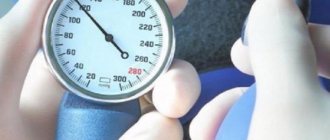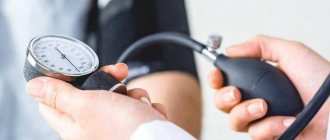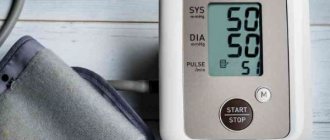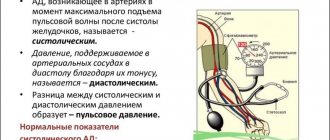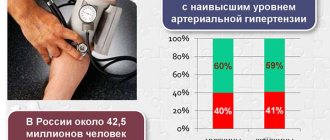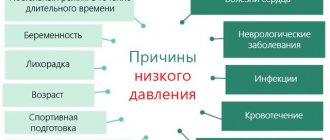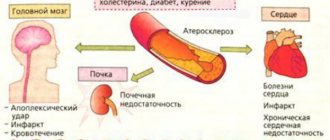What is considered normal?
The blood pressure indicator includes two components - the systolic (upper) pressure figure and the diastolic (lower) figure. They reflect the degree of resistance of the vascular wall at the moment of cardiac output, as well as the intervals between heartbeats.
In official medicine, there is still debate about what indicators are considered normal.
Until recently, the minimum permissible systolic value was considered to be 110 mmHg, and the maximum permissible was 140.
For the diastolic value, these figures were 60 mmHg. and 90. Thus, it turned out: 140 to 90 - the upper limit of the norm; 110 by 60 – bottom. Values that went beyond these limits were defined as pathology. The best value was considered to be 120 to 80.
The requirements of modern medicine have reduced the upper limit of normal to 130 to 80 mmHg.
It would seem that a pressure of 120 over 60 is within the normal range. But here it is necessary to take into account the fact that the normal gap between systolic and diastolic values should be 40 points (± 5).
This difference, called pulse pressure, in our case is 60 points. It significantly exceeds the norm, which is considered pathological.
However, when such numbers are shown by tonometry in young, practically healthy people or adolescents who feel well during the measurement, there is no reason to worry.
Also, the value can be quite normal at short stages of pregnancy.
Necessary examinations
The list of diagnostic measures is determined based on the suspected disease.
To draw primary conclusions, you will need to collect a list of the patient’s complaints and life history, also take into account family history, everyday life and a number of other factors.
All this falls on the shoulders of the cardiologist. If necessary, other specialists may be involved: endocrinologist, neurologist and nephrologist.
To verify the diagnosis, you will need the following methods:
- Assessment of blood pressure level, calculation of pulse blood pressure.
- Measuring the tonometer indicator within 24 hours using a special automatic monitor.
- Electrocardiography with stress tests. With such a high pulse pressure, it is carried out with great caution and a first aid team is on duty.
- Fainting is possible right during the diagnostic process.
- Echocardiography.
- Measuring brain activity.
- Blood tests for hormones and biochemical levels.
If necessary, angiography and other diagnostic techniques are prescribed. But in most cases, the ones listed are sufficient.
Who should worry with a blood pressure of 120 over 60?
If the gap between the systolic and diastolic pressure numbers is more than 50 or less than 30 points, the risk of heart pathologies increases.
These figures can be a cause for concern for an adult, especially one who has crossed the fifty-year mark. If the same indicators persist for a long time, this certainly indicates a circulatory disorder, which creates additional stress on the heart muscle.
The consequences of this condition often include: coronary heart disease, heart attack, stroke. In addition, similar indicators are often an early warning sign of Alzheimer's disease.
To prevent the development of diseases, be sure to make an appointment with a doctor. You should seek help immediately if such blood pressure is accompanied by:
- chills, the appearance of “flies” before the eyes;
- loss of strength, dizziness, drowsiness;
- increased heart rate;
- pain in the back of the head, temples;
- unstable emotional mood.
As a rule, these symptoms appear closer to night, and the condition may also worsen due to weather conditions.
Headaches with low blood pressure
Headaches with low blood pressure can vary in nature and intensity. They can increase quickly if pressure readings decrease sharply, or accompany the patient constantly. The following features are characteristic of pain due to hypotension:
- lack of precise localization - discomfort spreads to the entire surface of the head;
- additional symptoms: nausea and dizziness;
- chronic course, with alternating periods of relief and exacerbation.
If your blood pressure is constantly low and your head hurts, this indicator must be maintained with medication. With prolonged use, migraine may develop. This is an acute headache that does not go away even after normalization of blood pressure and significantly affects performance.
Reasons for decreased diastolic pressure
There are quite a lot of factors leading to a persistent decrease in lower blood pressure. These include: a combination of unfavorable circumstances, pathologies of the body. In a physically healthy person, a decrease in diastolic blood pressure can be caused by:
- poor nutrition, deficiency of vitamins B, E;
- lack of sleep;
- physical inactivity;
- overwork, stressful situations;
- climate change.
However, especially often, lower pressure is reduced due to existing pathologies:
- cardiovascular problems (atherosclerosis);
- kidney disease;
- endocrine diseases (hypothyroidism);
- infectious diseases (tuberculosis, pneumonia);
- tumor processes;
- cervical osteochondrosis;
- large blood loss (menstruation, surgery, trauma, perforated ulcers);
- long-term use of antihypertensive drugs;
To find out the reasons for the decrease in diastolic blood pressure, it is recommended to visit a therapist. After the examination, he will write a referral to a specialized specialist - a cardiologist, endocrinologist, neurologist or others.
Diagnostic methods
The reason why low blood pressure decreases can be determined through comprehensive diagnostics. The list of survey activities includes:
- General blood analysis. Biochemical research allows us to identify anemia, which often causes low blood pressure, especially in young women.
- ECG. An echocardiogram gives a complete picture of the structure of the heart and whether its functioning is normal. In this way, it is possible to determine heart valve disorders and other severe pathologies in a person of any gender and age.
- X-ray. Through X-ray examination, it is possible to identify a number of diseases that can lead to fluctuations in blood pressure, accompanied by an increase or decrease in heart rate.
What will help normalize blood pressure levels?
If no serious pathologies are detected with a blood pressure of 120/60 in an adult (elderly) person, the doctor will give recommendations for lifestyle correction. The rise in diastolic blood pressure is promoted by:
- daily physical activity, long walks in fresh air;
- long night sleep up to 8 hours;
- going to bed before 11 pm daily;
- set time for getting up in the morning;
- morning work-out;
- sports (swimming, cycling).
Good results can also be achieved by correcting the diet. The following products are considered mandatory for hypotension:
- nuts rich in vitamins B, E (hazelnuts, cashews, walnuts, sunflower seeds);
- wholemeal bread with bran;
- leafy greens (spinach, lettuce);
- fresh fruits, vegetables;
- lean meat, sea fish;
- good butter, as well as vegetable oils (olive, sunflower);
- spicy spices.
You need to eat in fractional portions. The number of meals is at least four, at equal intervals (three hours). Small doses of good dry red wine will also be beneficial.
How to measure a child's blood pressure
Measuring blood pressure in children has its own characteristics and is slightly different from a similar procedure in an adult.
- It is recommended to carry out the procedure in the morning, an hour after eating or walking. The child must visit the toilet and not be exposed to stress.
- The first time you take a measurement, you need to use both hands to determine where the pressure is higher.
- For a child under 2 years of age, the procedure is carried out in a lying position, for children older than this age - sitting, the legs should not hang down (if the baby does not reach the floor, install a stand).
- To measure, use a cuff according to size, since the component part of the tonometer for adults can distort the results of the study. For accurate measurement, the cuff should be ¾ of the distance from the armpit to the bend of the elbow.
Further, the procedure is no different from the usual sequence in adults. A phonendoscope is applied to the vein in the elbow, air is pumped in with a bulb and, after deflating the air, the beginning (systolic pressure) and end of the pulsation (diastolic blood pressure) are noted.
Blood pressure in children is always lower than in adults. The younger the body, the higher the elasticity of the vessels and the wider their lumen, which means that the pressure of blood on the lining of the arteries is minimal. As the child grows up, blood pressure gradually increases and by the end of adolescence reaches stable levels (110–120/70–80). Blood pressure in childhood can be affected by external factors - stress, overwork, trauma, physical activity, or internal diseases - cardiac, endocrine, renal pathologies.
Treatment of hypotension
Sometimes, lifestyle and dietary adjustments to raise blood pressure may not be enough. Then, the attending physician prescribes therapeutic treatment, recommending certain medications.
As a rule, herbal medicines are prescribed first. They have a delicate effect on the cardiovascular and nervous systems. Have a mild stimulating effect. Especially often, patients are recommended to take certain doses of the following alcohol tinctures:
- Eleutherococcus;
- aralia;
- lemongrass;
- ginseng.
If the therapeutic effect is insufficient, synthetic drugs can be added: anticholinergics, adrenergic agonists, nootropics, analeptics.
Only a doctor should recommend certain medications, set their dosage, and duration of use. Self-medication is unacceptable.
Excellent results are achieved using physiotherapeutic methods. This can be a massage, electrotherapy (Darsonval, electrosleep), baths with the addition of essential oils, Charcot's shower.
How can I help at home?
Blood pressure of 120/60 is not critical and is not accompanied by life-threatening conditions. However, if there is a headache or other unpleasant symptoms, they must be eliminated.
A contrast shower, which stimulates the functioning of the heart and blood vessels, will help to quickly increase lower pressure and relieve discomfort. A cup of sweet hot tea (black or green), a slice of dark chocolate, and alcohol will help get rid of dizziness due to hypotension. We are talking about cognac here. A piece of refined sugar is dipped into a strong drink, then slowly dissolved.
If after all the manipulations the condition does not stabilize, but worsens, it makes sense to call an ambulance. Before the doctors arrive, the person is placed comfortably with the head slightly elevated. Pressure items of clothing are removed or unbuttoned. Organize a flow of fresh air.
When chills are observed, it is advisable to begin rubbing the limbs (legs), rising from the calf muscles higher. The right solution would be a tablet or two of Citramon. The composition of the drug includes caffeine, which will slightly increase the lower pressure and alleviate the condition until the ambulance arrives.
To prevent unforeseen situations with jumps in blood pressure, it is necessary to undergo an annual medical examination and carefully follow the doctor’s recommendations.
Additional symptoms
Low diastolic pressure against a background of normal systolic pressure is usually accompanied by characteristic symptoms:
- A man has a headache.
- Your heart rate slows or your pulse becomes irregular.
- Dizziness occurs when you suddenly turn your head or come out of the dark into the light.
- Fainting, starting with darkening of the eyes, is possible.
- Memory deteriorates.
- Activity decreases, fatigue occurs even at rest.
- The patient becomes irritable, periods of apathy are replaced by aggression.
With both hypertension and hypotension, a person begins to react sharply to the vagaries of the weather with increased symptoms
